Statistical modeling of aircraft engine fuel burn
Author(s)
Chati, Yashovardhan Sushil
DownloadFull printable version (18.98Mb)
Other Contributors
Massachusetts Institute of Technology. Department of Aeronautics and Astronautics.
Advisor
Hamsa Balalakrishnan.
Terms of use
Metadata
Show full item recordAbstract
Fuel burn is a key driver of aircraft performance, and contributes to airline costs and aviation emissions. While the trajectory (ground track) of a flight can be observed using surveillance systems, its fuel consumption is generally not disseminated by the operating airline. Emissions inventories and benefits assessment tools therefore need models that can predict the fuel flow rate profile and fuel burn of a flight, given its trajectory data. Most existing fuel burn estimation tools rely on an architecture that is centered around the Base of Aircraft Data (BADA), an aircraft performance model developed by EUROCONTROL. Operational data (including trajectory data) are generally processed in order to generate the inputs needed by BADA, which then provides an estimate of the fuel flow rate and fuel burn. Although a versatile tool that covers a large number of aircraft types, BADA makes several assumptions that are not representative of real-world operations. Consequently, the reliance on BADA results in errors in the fuel burn estimates. Additionally, existing fuel burn modeling tools provide deterministic predictions, thereby not capturing the operational variability seen in practice. This thesis proposes an alternative model architecture that enables the development of data-driven, statistical models of fuel burn. The parameters of interest are the instantaneous fuel flow rate (that is, the mass of fuel consumed per unit time) and the fuel burn (cumulative mass of fuel consumed over a particular phase or the entire trajectory). The new model architecture uses supervised learning algorithms to directly map aircraft trajectory variables to the fuel flow rate, and subsequently, fuel burn. The models are trained and validated using operational data from flight recorders, and therefore reflect real-world operations. A physical understanding of aircraft and engine performance is leveraged for feature selection. An important characteristic of statistical methods is that they provide both estimates of mean values, as well as predictive distributions reflecting the variability and uncertainty. Locally expert models are developed for each aircraft type and for each of the flight phases. The Bayesian technique of Gaussian Process Regression (GPR) is found to be well-suited for modeling fuel burn. The resulting models are found to be significantly better than state-of-the-art aircraft performance models in predicting the fuel flow rate and fuel burn of a trajectory, giving up to a 63% improvement in total airborne fuel burn prediction over the BADA model. Finally, the Takeoff Weight (TOW) of an aircraft is recognized as an important variable for determining the fuel burn. The thesis therefore develops and evaluates a methodology to estimate the TOW of a flight, using trajectory data from its takeoff ground roll. The proposed statistical models are found to result in up to a 76% smaller error than the Aircraft Noise and Performance (ANP) database, which is used currently for TOW estimation.
Description
Thesis: Ph. D., Massachusetts Institute of Technology, Department of Aeronautics and Astronautics, 2018. Cataloged from PDF version of thesis. Includes bibliographical references (pages 169-177).
Date issued
2018Department
Massachusetts Institute of Technology. Department of Aeronautics and AstronauticsPublisher
Massachusetts Institute of Technology
Keywords
Aeronautics and Astronautics.